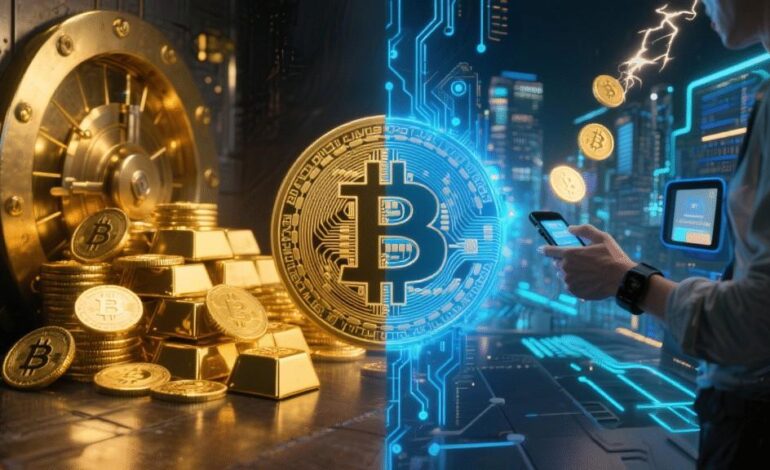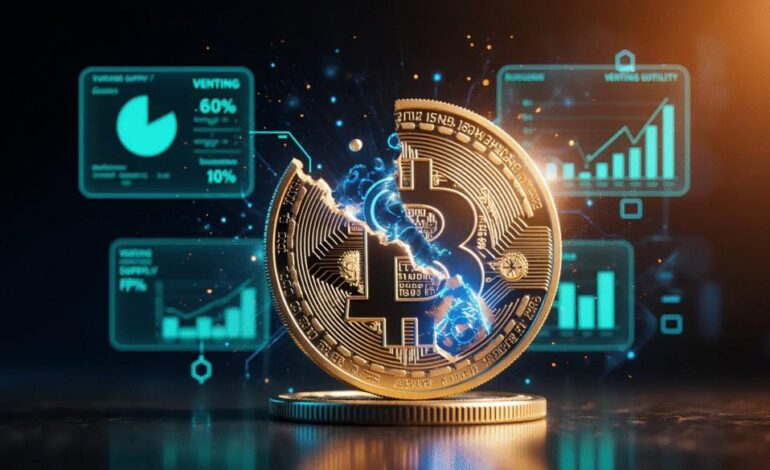Key Points
- Bitcoin works mainly as a store of value like gold due to its fixed supply of 21 million coins and decentralized nature.
- Layer 2 solutions like the Lightning Network allow Bitcoin to work as a fast and cheap payment method for everyday transactions.
- The cryptocurrency serves both roles at the same time and has its value storage function supporting its use as money.
Since 2009, Bitcoin has created endless debates about its true purpose. Satoshi Nakamoto designed it as peer-to-peer electronic cash. Yet the market quickly saw something different.
Today, most people treat it like gold rather than money they spend at the market.
Bitcoin Works Like Gold in Digital Form
The comparison to gold makes sense when you look at how Bitcoin works. Both are scarce, both exist outside government control, and both protect wealth over time.
Bitcoin’s code limits the total supply to 21 million coins, and no one can change this rule. This means that central banks (or anyone else) can’t print it whenever they want, just as they do with fiat.
This makes it valuable for people worried about inflation eating their savings.
Every four years, an event called the halving cuts the number of new Bitcoins created by half. This programmed scarcity is similar to how gold gets harder to mine over time.
The only difference is that Bitcoin’s scarcity is perfectly predictable.’
Governments Cannot Control Bitcoin
No single authority controls the Bitcoin network, and thousands of computers around the world verify every transaction. This decentralization protects it from government interference.
People living under authoritarian regimes or dealing with hyperinflation find this feature especially useful. Their governments can’t freeze Bitcoin accounts or inflate the supply. The network also exists beyond any single country’s reach.
Major institutions now buy Bitcoin to store value, and companies hold it on their balance sheets. Sovereign wealth funds allocate portions of their portfolios to it and the launch of Bitcoin ETFs in traditional markets has confirmed its status as an investment asset.
Payments With Bitcoin Face Real Obstacles
The original Bitcoin network has problems as a payment system. These limitations come from the same design choices that make it secure.
For example, transactions take about 10 minutes to confirm, and the network handles about seven within this timeframe. On the other hand, Visa processes thousands of transactions per second.
This speed gap makes retail payments difficult on the main network.
Fees are also another barrier to this. Fees tend to spike when many people use the network at once, and sending $5 might cost $15 in fees during busy periods.
The Lightning Network Changes Everything
Layer 2 solutions process transactions off the main Bitcoin blockchain, and the Lightning Network is a leader in this innovation.
The Lightning Network lets users open payment channels between each other. They then send money to one another through these channels. Transfers happen instantly and cost almost nothing.
At the end of the day, only the final settlement goes to the main blockchain, instead of the entire transaction details.
As a result, Bitcoin goes from being a tedious piece of technology to use to being usable money. People can now buy items, pay subscriptions and send remittances across borders in seconds. The fees also stay small, regardless of network congestion.
Both Roles Work Together
At the end of the day, Bitcoin doesn’t have to choose between being gold or currency. The two functions support each other in powerful ways.
People accept Bitcoin as payment because they trust it will hold value. Its reputation as digital gold also gives confidence to those receiving it.
The opposite also holds true, because making Bitcoin easy to spend brings new users into the system. More users strengthen the network effect, and a stronger network makes Bitcoin more valuable as a store of wealth.

Bitcoin works as both under different market conditions | source: X
Depending on market conditions, Bitcoin tends to work as either a currency or digital gold. When times are good, investors are comfortable with spending. When market conditions enter a downturn, investors choose to use Bitcoin as digital gold.
The Current State of Bitcoin
Evidence strongly supports one conclusion, and it’s that Bitcoin works mostly as a store of value today.
Most Bitcoin never moves, and holders keep it in wallets for years. On the other hand, people aren’t buying groceries with Bitcoin in any meaningful numbers.
The cryptocurrency’s price volatility also creates problems for everyday use. A currency needs stable value so businesses can set prices and manage accounting. Bitcoin’s price swings make this impossible for most merchants.
Overall, Bitcoin will likely continue to act as both over the foreseeable future. The cryptocurrency will likely be used more as a store of value in stable economies and the opposite in regions where traditional money fails people.
This being said, anyone can see Bitcoin as gold or money. It just depends partly on where you live and what you need.
For someone facing inflation, it’s protection. For someone needing to send money abroad, it’s a payment rail. For investors, it’s portfolio diversification.












